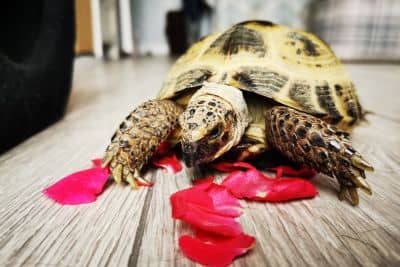Tortoises are renowned for their remarkable longevity. In fact, the Aldabra Giant tortoise has a reputation for being the longest-living land animal. Native to the Aldabra Atoll in the Seychelles, these ancient creatures are known to live well over 100 years, with some individuals even reaching or surpassing 150 years.
When kept as pets or in captivity, most species are expected to live longer than their wild relatives and it’s certainly not uncommon for them to outlive their human caretakers.
Genetic factors, environmental conditions, diet, habitat, and healthcare can contribute to how long a tortoise will live. And as I’m about to explain, all these factors play an important role in maximizing their lifespan if you plan on taking care of one.
- How To Age a Tortoise
- Care Tips for A Long Life
- Health Care and Regular Veterinary Visits
- Ethical Considerations
- Lifespan of Common Tortoise Species
- 1. Sulcata Tortoise (Centrochelys sulcata)
- 2. Russian Tortoise (Testudo horsfieldii)
- 3. Hermann’s Tortoise (Testudo hermanni)
- 4. Greek Tortoise (Testudo graeca)
- Lifespan in Captivity: Up to 100 years
- 5. Leopard Tortoise (Stigmochelys pardalis)
- 6. Red-footed Tortoise (Chelonoidis carbonaria)
- 7. Indian Star Tortoise (Geochelone elegans)
- 8. Marginated Tortoise (Testudo marginata)
- 9. Horsfield’s Tortoise or Asian Steppe Tortoise (Testudo horsfieldii)
- Citations
How To Age a Tortoise
Estimating the age and maturity of a tortoise can be tricky but there are certain physical characteristics that can indicate age. Features like the concavity of the plastron in males (which helps them mount females) or the size and shape of the tail can be an indicator of sexual maturity.
Counting the growth rings on a tortoise’s scutes can also give an indication of age in juveniles. Each ring typically represents a period of slower growth, which often corresponds to a winter season. However, this method is not always accurate, particularly for older tortoises, because the rings can become less distinct as the shell wears down over time.
Care Tips for A Long Life
As any conscientious tortoise keeper knows, good husbandry is the most important factor when it comes to the longevity of your pet. This means researching and having a thorough understanding of their native habitat so that you can replicate it for them in captivity.
Environmental Conditions
Before you have even decided on a species, it’s a good idea to understand the environmental conditions of their native homes, then decide how best you can mimic it.
The table below shows the temperature and humidity ranges for some of the most popular pet tortoise species.
| Species | Basking Temp(°F) | Cooler Temp (°F) | Humidity Range (%) |
| Sulcata | 95-100 | 40-55 | 70-80 |
| Russian | 95-100 | 30-50 | 70-75 |
| Hermann’s | 85-90 | 30-70 | 70-75 |
| Greek | 85-90 | 30-60 | 70-75 |
| Leopard | 85-90 | 40-60 | 70-75 |
| Red-footed | 90-95 | 70-80 | 70-80 |
| Indian Star | 85-95 | 55-75 | 75-80 |
| Marginated | 85-90 | 30-60 | 70-75 |
| Horsfield’s | 85-90 | 30-50 | 65-75 |
The question to ask yourself is, what are the highest and lowest temperature and humidity ranges in your region? Understanding this will help you decide whether you should locate your tortoise enclosure indoors or outside.
Enclosures
Pet tortoises need secure housing that prevents them from getting out, and stops other pets, predators, and undesirables from getting in. They also need space to roam and an area that’s big enough to provide a place to keep warm and cool down.
The enclosure then needs to accommodate items such as vegetation, logs, a shelter and rocks or mounds of substrate then provide interest and exercise for your tortoise.
As a starting point, I recommend a pen that is at least 5 x the shell length long and 3 x the shell length wide of your tortoise when it’s fully grown. Ideally bigger, and double this if you have more than one tortoise.
Diet
For captive tortoises to thrive, they need a very particular diet that is high in fiber but low in protein and fat.
Leafy greens, grasses, and some vegetables should form the bulk of their diet. Occasional fruits can be offered, but sparingly to prevent excessive sugar intake.
Calcium also forms a vitally important role in a tortoise’s diet, and without it, they can be prone to shell deformities and life-limiting metabolic bone disease.
In the wild, their absorption of calcium is dependent on eating calcium rich foods and synthesizing Vitamin D3 through the UVB rays of the sun. Mimicking this in a captive environment with a similar herbaceous diet and UVB light will help to ensure good health and longevity.
Obesity is a common problem for pet tortoises which can put a strain on their organs and lead to premature death. This problem is largely thanks to overzealous keepers and underactive tortoises.
To avoid overfeeding in adult tortoises, I recommend limiting food intake to every other day. For juveniles, daily feeding is required, but limit this to a 20–30-minute window.
Enrichment
Ensuring your pet tortoise lives an enriched life is not only beneficial to their mental and physical well-being, but it can also help to prevent life-limiting stress-related health issues.
Are You Starving Your Tortoise?
Save 10% on premium tortoise food and supplements from Tortoise Resource Center on Amazon now using code BUYNOWGET10
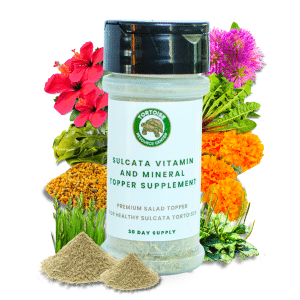
Sulcata Vitamin & Mineral Topper Supplement
30-Day Supply | 2 oz (56 g)
$24.99
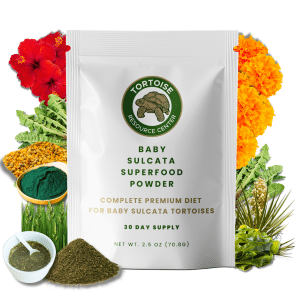
Baby Sulcata Tortoise Superfood Powder
30-Day Supply | 2.5 oz (70.8 g) Bag
$24.99
Encouraging Natural Behaviors
In their natural environment, tortoises spend a considerable part of their day searching for food.
You can replicate this by providing a variety of food items and spreading them around their enclosure. This encourages natural foraging behavior, which is both mentally stimulating and physically beneficial.
You could also try introducing new objects or changes in the enclosure layout to stimulate curiosity and problem-solving skills. I recommend adding new edible plants, different substrates for burrowing, or obstacles to navigate around.
Placing enrichment objects such as rocks, mounds of dirt and hollowed out logs will help to keep your tortoise active and provide some well-needed exercise.
Prevention of Stress-Related Health Issues
A lack of enrichment can lead to boredom, frustration, and stress. In turn, this can lead to behavior such as pacing or digging, and this can be detrimental to a tortoise’s health.
Chronic stress in tortoises can lead to suppressed immune systems and make them more susceptible to diseases.
By providing an enriched environment, filled with interest, challenges and activities, you can help to mitigate stress by keeping your tortoise engaged and satisfied.
Physical Health Maintenance
Physical activity such a climbing over obstacles or burrowing helps to maintain muscle tone and prevent obesity. Without muscle tone, tortoises can have difficulty moving and can even flip over, which can be fatal if a tortoise cannot right itself.
Mental Well-being
Just like humans, tortoises can benefit from mental stimulation to maintain their cognitive function.
Engaging with their environment allows them to use their senses and problem-solving skills, which can help maintain cognitive functions as they age.
Enrichment can also improve overall happiness and quality of life by providing opportunities to engage in enjoyable and stimulating activities.
All these enrichment factors contribute directly to enhancing longevity. For example, a tortoise that is mentally stimulated, physically active, and free from chronic stress is likely to have a stronger immune system and fewer health problems, thereby potentially increasing its lifespan.
However, longevity is not just about the number of years lived, it is also about the quality of those years. Enrichment ensures that the years are lived to the fullest, with minimal discomfort and maximum engagement.
Health Care and Regular Veterinary Visits
Tortoises are very good at masking the early signs and symptoms of ill health, so I like to get mine checked out with 6-monthly veterinary check-ups.
I tend to get them booked in around late summer before any hibernation-related preparations start.
This is a great way to prevent, detect and treat health issues early. It’s also an opportunity to get advice from an expert to ensure you’re ticking all the boxes when it comes to nutrition, habitat conditions, and disease prevention.
Having a proactive approach has always stood my tortoises in good stead when it comes to enhancing their quality of life, welfare, and ultimately, their longevity.
Common Health Issues and Treatments
The table below highlights the most common health issues in pet tortoises, all of which can hinder and, in some cases, prevent a long and healthy life.
| Health Issue | Causes | How to Prevent |
| Nutritional Deficiencies | Lack of calcium and vitamin D3 in the diet | Ensure a balanced diet rich in calcium, provide UVB lighting, and consult a vet for dietary adjustments. |
| Respiratory Infections | Poor living conditions like incorrect humidity or temperature | Maintain proper temperature and humidity levels, and ensure the habitat is well-ventilated. |
| Shell Problems | Dietary imbalances, trauma, unsanitary conditions | Provide a balanced diet, maintain a clean habitat, and ensure safe environmental settings. |
| Parasitic Infections | Contaminated food, poor hygiene | Conduct regular fecal exams, maintain hygiene, and ensure fresh, clean food and water. |
| Metabolic Bone Disease (MBD) | Insufficient calcium or vitamin D in the diet | Provide UVB lighting for vitamin D synthesis and include adequate dietary calcium. |
| Overgrown Beak and Nails | Inadequate diet, lack of natural wear | Provide rough surfaces for natural wear and consider professional trimming if necessary. |
| Dehydration | Lack of fresh water, improper humidity levels | Ensure consistent access to fresh water and maintain appropriate humidity; regular soaking may help. |
Ethical Considerations
Before committing to keeping a tortoise – a pet that often outlives its owner – I encourage you to consider the ethics of their long-term care and responsibility by mapping out how it will be taken care of for the entirety of its life.
As an alternative, you may wish to consider the potentially more responsible option of adoption or rescuing a tortoise.
This alternative route to tortoise-keeping not only provides a home to an animal in need but also alleviates the issues stemming from overbreeding and the exotic pet trade.
Lifespan of Common Tortoise Species
As well as how well a tortoise is looked after, their specific lifespan varies significantly depending on its species.
Here’s a look at some of the more common pet tortoise species and their expected longevity both in captivity and in the wild.
1. Sulcata Tortoise (Centrochelys sulcata)
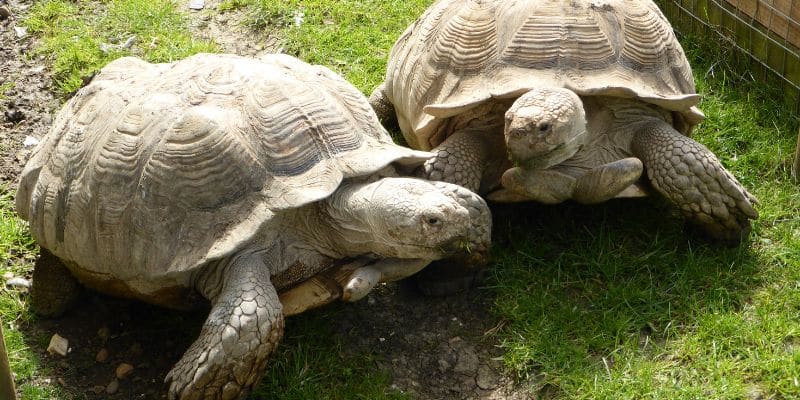
Lifespan in Captivity: 50-70 years
Lifespan in the Wild: Usually shorter due to predation and environmental factors.
Care Guidelines: Sulcata tortoises require a dry, warm environment with access to grassy vegetation for grazing. A sulcata’s diet should primarily consist of grasses and hay. They need a large outdoor enclosure with a heated shelter for cold nights. Overfeeding can lead to health issues and reduced lifespan.
Life Limiting Factors: Improper diet, inadequate housing, and lack of proper veterinary care.
2. Russian Tortoise (Testudo horsfieldii)
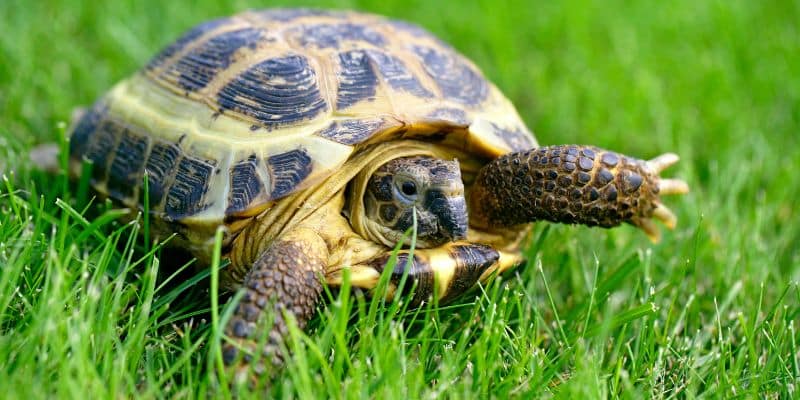
Lifespan in Captivity: 40-50 years
Lifespan in the Wild: Slightly less, due to predation and harsh climates.
Care Guidelines: Russian tortoises thrive in a temperate outdoor enclosure with a variety of safe plants to graze on. They require a burrow for escaping extreme temperatures. A balanced diet with plenty of fiber and minimal protein is crucial.
Life Limiting Factors: Vitamin deficiencies, respiratory infections due to cold and damp conditions.
3. Hermann’s Tortoise (Testudo hermanni)
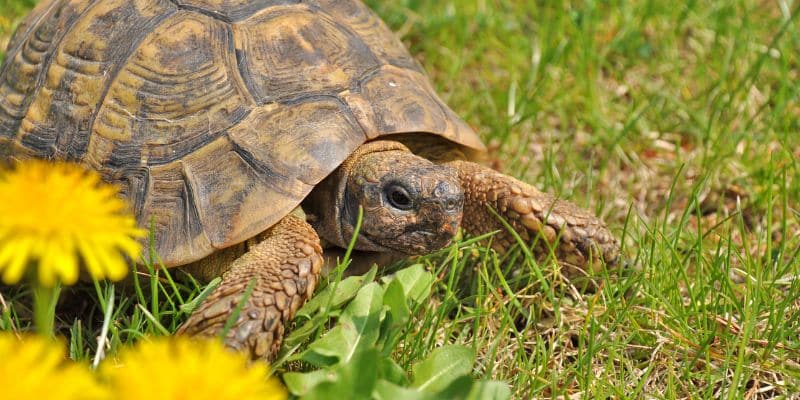
Lifespan in Captivity: 50-80 years
Lifespan in the Wild: Comparable to captivity, but dependent on environmental pressures.
Care Guidelines: They need a spacious enclosure with access to sunlight and shaded areas. Diet should include leafy greens and some fruits. Caring for Hermann’s tortoises also requires regular health checks to help in the prevention of diseases.
Life Limiting Factors: Metabolic bone disease from lack of UV light, shell deformities from improper nutrition.
4. Greek Tortoise (Testudo graeca)
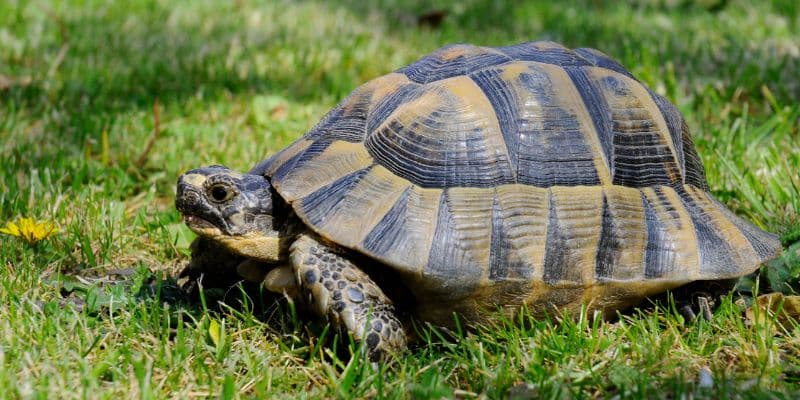
Lifespan in Captivity: Up to 100 years
Lifespan in the Wild: Generally shorter due to environmental stresses and human activity.
Care Guidelines: They require a dry habitat and a diet rich in fibrous plants with minimal fruits and proteins. Calcium and vitamin supplements are beneficial.
Life Limiting Factors: Predation, habitat loss, and inadequate captive care leading to health issues like shell rot.
5. Leopard Tortoise (Stigmochelys pardalis)
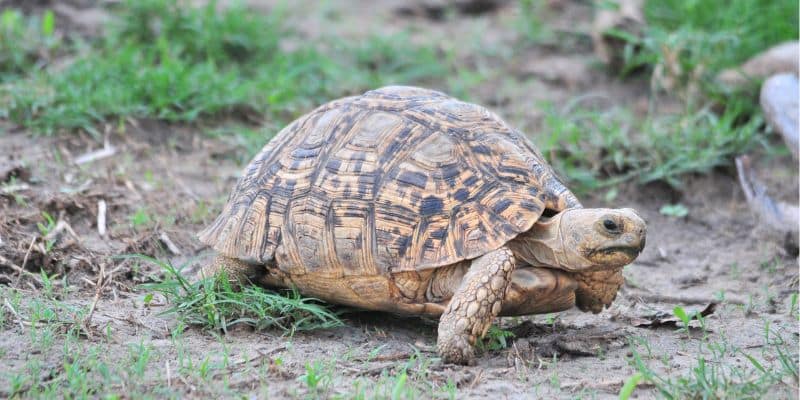
Lifespan in Captivity: 50-100 years
Lifespan in the Wild: Generally less due to predation and environmental factors.
Care Guidelines: Leopard tortoises require a large, secure outdoor enclosure with a variety of grasses and edible plants. They need a dry climate with a basking spot. Adequate UV exposure and temperature regulation are crucial. The diet should primarily include high-fiber grasses, with calcium supplementation.
Life Limiting Factors: Respiratory infections from cold or damp conditions, shell pyramiding from poor nutrition.
6. Red-footed Tortoise (Chelonoidis carbonaria)

Lifespan in Captivity: 50-60 years
Lifespan in the Wild: Often less, due to habitat destruction and hunting.
Care Guidelines: This species requires a humid environment and a varied diet including fruits, vegetables, and a small amount of animal protein. They need access to both sunny and shaded areas. Consistent temperature and humidity control are essential.
Life Limiting Factors: Respiratory diseases, shell rot, and metabolic bone disease from insufficient UV light.
7. Indian Star Tortoise (Geochelone elegans)

Lifespan in Captivity: 30-80 years
Lifespan in the Wild: Less due to poaching and loss of habitat.
Care Guidelines: The Indian Star Tortoise requires a warm, humid environment with controlled exposure to UV light. Their diet should include a variety of leafy greens and flowers, supplemented with calcium. Avoid overly damp conditions to prevent fungal infections.
Life Limiting Factors: Stress from overcrowding, respiratory problems, and shell diseases.
8. Marginated Tortoise (Testudo marginata)
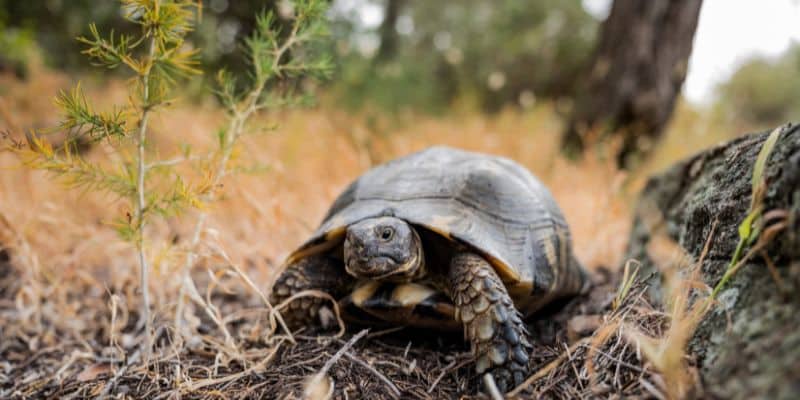
Lifespan in Captivity: Up to 100 years
Lifespan in the Wild: Comparable, though less common due to habitat threats.
Care Guidelines: They need a spacious enclosure with a variety of vegetation and a good basking area. Diet should be rich in calcium and fiber, with minimal fruit. Provide UV lighting and maintain a dry environment to prevent shell and skin issues.
Life Limiting Factors: Vitamin deficiencies and metabolic bone disease due to improper lighting.
9. Horsfield’s Tortoise or Asian Steppe Tortoise (Testudo horsfieldii)
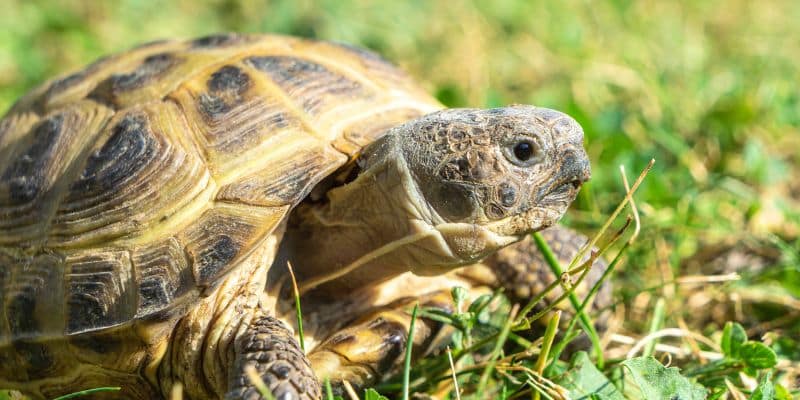
Lifespan in Captivity: 40-75 years
Lifespan in the Wild: Less, due to harsh environmental conditions.
Care Guidelines: Requires a dry setup with a deep substrate for burrowing. The diet should be varied with a focus on leafy greens and some vegetables. They need a cooler nighttime temperature than some other species.
Life Limiting Factors: Respiratory infections if kept too damp or cold, and shell deformities from improper diet.
Citations
PetMed – How Long Do Tortoises Live
Research Gate – Adult Tortoise Survival Rates


